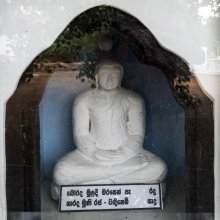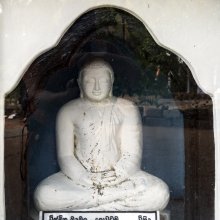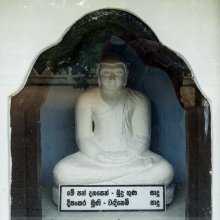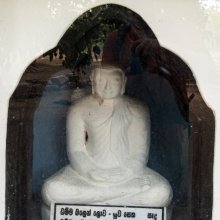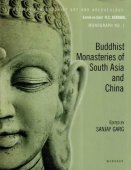Pali, Pālin, Palin, Pālī, Pāli: 40 definitions
Introduction:
Pali means something in Buddhism, Pali, Hinduism, Sanskrit, Jainism, Prakrit, the history of ancient India, Marathi, Hindi, biology, Tamil. If you want to know the exact meaning, history, etymology or English translation of this term then check out the descriptions on this page. Add your comment or reference to a book if you want to contribute to this summary article.
Images (photo gallery)
(+23 more images available)
In Hinduism
Purana and Itihasa (epic history)
Source: archive.org: Puranic EncyclopediaPālī (पाली).—A corrupt form of Sanskrit.
Source: Cologne Digital Sanskrit Dictionaries: The Purana IndexPālin (पालिन्).—A son of Pṛthu.*
- * Vāyu-purāṇa 63. 22.

The Purana (पुराण, purāṇas) refers to Sanskrit literature preserving ancient India’s vast cultural history, including historical legends, religious ceremonies, various arts and sciences. The eighteen mahapuranas total over 400,000 shlokas (metrical couplets) and date to at least several centuries BCE.
Ayurveda (science of life)
Source: gurumukhi.ru: Ayurveda glossary of termsPāli (पालि):—[pāliḥ] Lobule. A small lobe or primary subdivision of a lobe

Āyurveda (आयुर्वेद, ayurveda) is a branch of Indian science dealing with medicine, herbalism, taxology, anatomy, surgery, alchemy and related topics. Traditional practice of Āyurveda in ancient India dates back to at least the first millenium BC. Literature is commonly written in Sanskrit using various poetic metres.
Vastushastra (architecture)
Source: OpenEdition books: Architectural terms contained in Ajitāgama and RauravāgamaPāli (पालि) refers to “plate (element of the crowning motif) § 3.31.”.—(For paragraphs cf. Les enseignements architecturaux de l'Ajitāgama et du Rauravāgama by Bruno Dagens)

Vastushastra (वास्तुशास्त्र, vāstuśāstra) refers to the ancient Indian science (shastra) of architecture (vastu), dealing with topics such architecture, sculpture, town-building, fort building and various other constructions. Vastu also deals with the philosophy of the architectural relation with the cosmic universe.
Sports, Arts and Entertainment (wordly enjoyments)
Source: archive.org: Syainika Sastra of Rudradeva with English Translation (art)Pāli (पालि) refers to “mantling (with the wings)” (of a hawk), according to the Śyainika-śāstra: a Sanskrit treatise dealing with the divisions and benefits of Hunting and Hawking, written by Rājā Rudradeva (or Candradeva) in possibly the 13th century.—Accordingly, [while discussing the training of hawks]: “[...] Whether it is ‘manned’ or not is to be known by its actions. When it stands on one leg with the eyes closed, when it preens or ‘reforms’ its feathers, when it ‘mantles’ with its wings (pakṣa-pāli) [cañcvā kaṇḍūyanaṃ caiva pakṣapālyorvidhūnanam], or looks with a gentle eye at its master, then it is known to be ‘manned’, otherwise not. When the hawk is seen to be manned it should be lured in a creance to a piece of meat from increasing distances. [...]”.

This section covers the skills and profiencies of the Kalas (“performing arts”) and Shastras (“sciences”) involving ancient Indian traditions of sports, games, arts, entertainment, love-making and other means of wordly enjoyments. Traditionally these topics were dealt with in Sanskrit treatises explaing the philosophy and the justification of enjoying the pleasures of the senses.
In Buddhism
Theravada (major branch of Buddhism)
Source: Access to Insight: A Glossary of Pali and Buddhist TermsThe canon of texts (see Tipitaka) preserved by the Theravada school and, by extension, the language in which those texts are composed.Source: Pali Kanon: Pali Proper NamesSee Mahapali and Suvannapali.
Source: Dhamma Study: CetasikasPali is the language of the Buddhist scriptures of the Theravada tradition.
Theravāda is a major branch of Buddhism having the the Pali canon (tipitaka) as their canonical literature, which includes the vinaya-pitaka (monastic rules), the sutta-pitaka (Buddhist sermons) and the abhidhamma-pitaka (philosophy and psychology).
Tibetan Buddhism (Vajrayana or tantric Buddhism)
Source: MDPI Books: The Ocean of HeroesPālin (पालिन्) (Cf. Pālinī) refers to the “guardian” (of the world), according to the 10th-century Ḍākārṇava-tantra: one of the last Tibetan Tantric scriptures belonging to the Buddhist Saṃvara tradition consisting of 51 chapters.—Accordingly: [while describing the earth-circle (medinīcakra)]: “[...] He should place [them] in order (1) Indrī, (2) Yamā, (3) Rudrā, (4) Yakṣiṇī, (5) Bhūtinī, (6) Ṛṣī, (7) Rākṣasī, and (8) Vāyubhāryā—he should place the female world guardians (loka-pālinī). There are [also] female serpents and female clouds. He should place all [of them] on this [circle] completely. [...]”.

Tibetan Buddhism includes schools such as Nyingma, Kadampa, Kagyu and Gelug. Their primary canon of literature is divided in two broad categories: The Kangyur, which consists of Buddha’s words, and the Tengyur, which includes commentaries from various sources. Esotericism and tantra techniques (vajrayāna) are collected indepently.
General definition (in Buddhism)
Source: Buddhist Door: GlossaryThe language of the Theravada (Hinayana) Buddhist Canon, alleged to be the language used by the Buddha.In Jainism
General definition (in Jainism)
Source: archive.org: Personal and geographical names in the Gupta inscriptions (jainism)Pāli (पालि) is a Prakrit ending for deriving proper personal names, mentioned as an example in the Aṅgavijjā chapter 26. This chapter includes general rules to follow when deriving proper names. The Aṅgavijjā (mentioning pāli) is an ancient treatise from the 3rd century CE dealing with physiognomic readings, bodily gestures and predictions and was written by a Jain ascetic in 9000 Prakrit stanzas.
Source: The University of Sydney: A study of the Twelve ReflectionsPālin (पालिन्) refers to “one who protects (a door)”, according to the 11th century Jñānārṇava, a treatise on Jain Yoga in roughly 2200 Sanskrit verses composed by Śubhacandra.—Accordingly, “A bad birth is hard to be accomplished even in a dream for him whose judgment, which is extremely skilful at examination like a door-keeper (dvāra-pālin), shines in the mind. Having got rid of the multitude of imaginings, when the steady mind holds onto [its] nature, then it is indeed the best [form of] stopping the influx of karma for a mendicant”.
Synonyms: Pālika.

Jainism is an Indian religion of Dharma whose doctrine revolves around harmlessness (ahimsa) towards every living being. The two major branches (Digambara and Svetambara) of Jainism stimulate self-control (or, shramana, ‘self-reliance’) and spiritual development through a path of peace for the soul to progess to the ultimate goal.
India history and geography
Source: Cologne Digital Sanskrit Dictionaries: Indian Epigraphical GlossaryPāli.—name of a language. Note: pāli is defined in the “Indian epigraphical glossary” as it can be found on ancient inscriptions commonly written in Sanskrit, Prakrit or Dravidian languages.
--- OR ---
Pālī.—(EI 3), embankment. (CII 3), a bridge. Note: pālī is defined in the “Indian epigraphical glossary” as it can be found on ancient inscriptions commonly written in Sanskrit, Prakrit or Dravidian languages.
Source: Institut Français de Pondichéry: The Shaivite legends of Kanchipurampāli (பாலி) (in Tamil) refers to one of the proper nouns mentioned in the Kanchipuranam, which narrates the Shaivite Legends of Kanchipuram—an ancient and sacred district in Tamil Nadu (India). The Kanchipuranam (mentioning pāli) reminds us that Kanchipuram represents an important seat of Hinduism where Vaishnavism and Shaivism have co-existed since ancient times.

The history of India traces the identification of countries, villages, towns and other regions of India, as well as mythology, zoology, royal dynasties, rulers, tribes, local festivities and traditions and regional languages. Ancient India enjoyed religious freedom and encourages the path of Dharma, a concept common to Buddhism, Hinduism, and Jainism.
Biology (plants and animals)
Source: Google Books: CRC World Dictionary (Regional names)1) Pali in India is the name of a plant defined with Gossypium arboreum in various botanical sources. This page contains potential references in Ayurveda, modern medicine, and other folk traditions or local practices It has the synonym Gossypium arboreum Parl. (among others).
2) Pali is also identified with Hibiscus rosa-sinensis It has the synonym Hibiscus chinensis hort. (etc.).
3) Pali is also identified with Plumbago zeylanica It has the synonym Plumbago rosea L. (etc.).
4) Pali is also identified with Zingiber officinale It has the synonym Amomum zinziba Hill (etc.).
Example references for further research on medicinal uses or toxicity (see latin names for full list):
· Hereditas (Beijing) (1995)
· Flora of Tropical East Africa, Plumbaginaceae (1976)
· Zingiberaceae
· Flora of Southern Africa (1963)
· China Cottons (1984)
· Journal of Cytology and Genetics (1998)
If you are looking for specific details regarding Pali, for example chemical composition, diet and recipes, health benefits, pregnancy safety, side effects, extract dosage, have a look at these references.

This sections includes definitions from the five kingdoms of living things: Animals, Plants, Fungi, Protists and Monera. It will include both the official binomial nomenclature (scientific names usually in Latin) as well as regional spellings and variants.
Languages of India and abroad
Pali-English dictionary
Source: BuddhaSasana: Concise Pali-English Dictionarypāli : (f.) a line; range; the canon of the Buddhist writings or the language in which it is written. || paḷi (f.) a line; range; the canon of the Buddhist writings or the language in which it is written.
Source: Sutta: The Pali Text Society's Pali-English DictionaryPāli, (Pāḷi) (f.) (cp. Sk. pālī a causeway, bridge Halāyudha III, 54) 1. a line, row Dāvs III, 61; IV, 3; Vism. 242 (dvattiṃs’ākāra°), 251 (danta°); SnA 87.—2. a line, norm, thus the canon of Buddhist writings; the text of the Pāli Canon, i.e. the original text (opp. to the Commentary; thus “pāliyaṃ” is opposed to “aṭṭhakathāyaṃ” at Vism. 107, 450, etc). It is the literary language of the early Buddhists, closely related to Māgadhī. See Grierson, The Home of Lit. Pāli (Bhandarkar Commemoration vol. p. 117 sq.), and literature given by Winternitz, Gesch. d. Ind. Litt. , II. 10; III, 606, 635. The word is only found in Commentaries, not in the Piṭaka. See also Hardy, Introd. to Nett, p. xi.—J. IV, 447 (°nayena accord. to the Pāli Text); Vism. 376 (°nay’anusārena id.), 394, 401, 565 (°anusārato accord. to the text of the Canon); 607, 630, 660 sq. , 693, 712; KhA 41; SnA 333, 424, 519, 604; DhsA. 157, 168; DhA. IV, 93; VvA. 117, 203 (pālito+aṭṭhuppattito); PvA. 83, 87, 92, 287; and frequent elsewhere.—vaṇṇanā is explanation of the text (as regards meaning of words), purely textual criticism, as opposed to vinicchaya-kathā analysis, exegesis, interpretation of sense Vbh. 291; Vism. 240 (contrasted to bhāvanāniddesa). (Page 455)
— or —
Pali°, (a variant of pari°, to be referred to the Māgadhī dialect in which it is found most frequently, esp. in the older language, see Pischel, Prk. Gr. § 257; Geiger, P. Gr. § 44) round, around (=pari) only as prefix in cpds. (q. v.). Often we find both pari° & pali° in the same word. (Page 440)

Pali is the language of the Tipiṭaka, which is the sacred canon of Theravāda Buddhism and contains much of the Buddha’s speech. Closeley related to Sanskrit, both languages are used interchangeably between religions.
Marathi-English dictionary
Source: DDSA: The Molesworth Marathi and English Dictionarypāli (पालि) [or पाली, pālī].—f S The curving edge of the auricle, the helix. 2 Circumference.
--- OR ---
pāḷī (पाळी).—f A turn or recurring season: also an alternation or a vicissitude, a turn, spell, bout. 2 Lot or allotment; state or portion assigned. (For kuḷavācī pāḷī) A turn or bout (over ploughed ground) of the kuḷava (harrow); and, sometimes (over ground gen.) of the nāṅgara (plough). v ghāla.
--- OR ---
pāḷī (पाळी).—f (Poetry. pāli S) An encircling body or line (of troops, trees, wall, hedge &c.)
Source: DDSA: The Aryabhusan school dictionary, Marathi-Englishpaḷī (पळी).—f A ladle gen.
--- OR ---
pāḷī (पाळी).—f A turn. Lot or allotment. An encircling body or line.
Marathi is an Indo-European language having over 70 million native speakers people in (predominantly) Maharashtra India. Marathi, like many other Indo-Aryan languages, evolved from early forms of Prakrit, which itself is a subset of Sanskrit, one of the most ancient languages of the world.
Sanskrit dictionary
Source: DDSA: The practical Sanskrit-English dictionaryPali (पलि).—f. A part of the elephant's face, perhaps the hollow in the middle of the forehead; Mātaṅga L.6.1.
Derivable forms: paliḥ (पलिः).
--- OR ---
Pāli (पालि) or Pālī (पाली).—f.
1) The tip of the ear; श्रवणपालिः (śravaṇapāliḥ) Gītagovinda 3.
2) The edge, skirt, margin; तिष्ठतो युगपालीषु (tiṣṭhato yugapālīṣu) Mahābhārata (Bombay) 7.191. 3; महति सितपटच्छन्नपालीं कपालीम् (mahati sitapaṭacchannapālīṃ kapālīm) Bhartṛhari 3.55.
3) The sharp side, edge or point of anything (aśri); कपोलपालिं तव तन्वि मन्ये लावण्यधन्ये दिशमुत्तराख्याम् (kapolapāliṃ tava tanvi manye lāvaṇyadhanye diśamuttarākhyām) Bv.2.9.
4) Boundary, limit.
5) A line, row; विपुलपुलकपाली (vipulapulakapālī) Gītagovinda 6; Śiśupālavadha 3.51; रजनीचरपालिरागमिष्यत्यविलम्बं प्रतिपाल्यतां कुमारौ (rajanīcarapālirāgamiṣyatyavilambaṃ pratipālyatāṃ kumārau) Rām. Ch. 2.52.
6) A spot, mark.
7) A causeway, bridge.
8) The lap or bosom.
9) An oblong pond.
1) Maintenance of a pupil by his teacher during the period of his studies.
11) A louse.
12) Praise, eulogium.
13) A woman with a beard.
14) The hip.
15) A measure of capacity (prastha).
16) A circumference.
-lī A pot, boiler.
Derivable forms: pāliḥ (पालिः).
Source: Cologne Digital Sanskrit Dictionaries: Shabda-Sagara Sanskrit-English DictionaryPāli (पालि).—f.
(-liḥ or līḥ) 1. The sharp edge of a sword, or any cutting instrument. 2. The tip of the ear. 3. A line, a row or range. 4. A mark, a spot, a stain. 5. A louse. 6. A woman with a beard. 7. A boundary, a limit. 8. A raised bank, a causeway, a bridge. 9. A circumference. 10. Maintenance of a scholar during the period of his studies, by his teacher. 11. Praise, eulogium. 12. The hip or haunch. 13. A Prast'ha or measure so called. 14. The lap, the bosom. E. pāl to nourish, iṇ aff., and in most cases, ṅīp being optionally added, also pālī: see pāla.
Pāli can also be spelled as Pālī (पाली).
Source: Cologne Digital Sanskrit Dictionaries: Shabda-Sagara Sanskrit-English DictionaryPālin (पालिन्).—mfn. (-lī-linī-li) Who or what nourishes or protects. E. pāl to protect, ṇini aff.
Source: Cologne Digital Sanskrit Dictionaries: Benfey Sanskrit-English DictionaryPāli (पालि).—and pālī pālī, f. 1. The tip of the ear, [Gītagovinda. ed. Lassen.] 3, 13. 2. The edge of a sword or any other cutting instrument. 3. A line or row, [Gītagovinda. ed. Lassen.] 6, 10. 4. A raised bank, a dike, [Rājataraṅgiṇī] 5, 106 (lī). 5. A boundary, a margin, [Bhartṛhari, (ed. Bohlen.)] 3, 24 (lī).
Source: Cologne Digital Sanskrit Dictionaries: Benfey Sanskrit-English DictionaryPālin (पालिन्).—i. e. 2. pā, [Causal.], + in, adj., f. nī, Protecting, [Bhāgavata-Purāṇa, (ed. Burnouf.)] 3, 21, 50.
Source: Cologne Digital Sanskrit Dictionaries: Cappeller Sanskrit-English DictionaryPāli (पालि).—[feminine] the tip of the ear; edge, margin, side i.[grammar]; row, range, line; raised bank, dike; pot, boiler; an oblong pond (only pālī).
--- OR ---
Pālī (पाली).—[feminine] the tip of the ear; edge, margin, side i.[grammar]; row, range, line; raised bank, dike; pot, boiler; an oblong pond (only pālī).
--- OR ---
Pālī (पाली).—v. pāla & pāli.
Source: Cologne Digital Sanskrit Dictionaries: Cappeller Sanskrit-English DictionaryPālin (पालिन्).—[adjective] guarding, protecting; [masculine] ruler, king.
Source: Cologne Digital Sanskrit Dictionaries: Monier-Williams Sanskrit-English Dictionary1) Pālī (पाली):—[from pāla > pāl] f. a herdsman’s wife, [Mahābhārata v, 3608]
2) [v.s. ...] an oblong pond (as ‘receptacle’ of water?), [Varāha-mihira] (cf. pāli).
3) Pāli (पालि):—[from pālana > pāl] a m. ([probably]) a protector, ruler (cf. go-pāli and prajā-p).
4) b f. (in most meanings and ifc. f (also ī). cf. under pāla; according to, [Uṇādi-sūtra iv, 529 [Scholiast or Commentator]] [from] √pal) the tip or lobe of the ear, the outer ear, [Suśruta] (cf. karṇaand śravaṇa-p)
5) a boundary, limit, margin, edge, [Mahābhārata; Kāvya literature] etc.
6) a row, line, range, [Ratnāvalī; Śiśupāla-vadha; Gīta-govinda]
7) a dam, dike, bridge, [Rājataraṅgiṇī]
8) a pot, boiler, [Hemacandra’s Pariśiṣṭaparvan]
9) a [particular] measure of capacity (= prastha), [cf. Lexicographers, esp. such as amarasiṃha, halāyudha, hemacandra, etc.]
10) prescribed food, maintenance of a scholar during the period of his studies by his teacher, [cf. Lexicographers, esp. such as amarasiṃha, halāyudha, hemacandra, etc.]
11) the lap, bosom, [cf. Lexicographers, esp. such as amarasiṃha, halāyudha, hemacandra, etc.]
12) a circumference, [cf. Lexicographers, esp. such as amarasiṃha, halāyudha, hemacandra, etc.]
13) a mark, spot, [cf. Lexicographers, esp. such as amarasiṃha, halāyudha, hemacandra, etc.]
14) a louse, [cf. Lexicographers, esp. such as amarasiṃha, halāyudha, hemacandra, etc.]
15) a woman with a beard, [cf. Lexicographers, esp. such as amarasiṃha, halāyudha, hemacandra, etc.] = praśaṃsā, [cf. Lexicographers, esp. such as amarasiṃha, halāyudha, hemacandra, etc.] (lī ifc. to denote praise, [Gaṇ.])
16) = prabedha, [cf. Lexicographers, esp. such as amarasiṃha, halāyudha, hemacandra, etc.]
Source: Cologne Digital Sanskrit Dictionaries: Monier-Williams Sanskrit-English Dictionary1) Pālin (पालिन्):—[from pālana > pāl] mfn. protecting, guarding, keeping, [Śukasaptati; Bhāgavata-purāṇa]
2) [v.s. ...] m. (ifc.) a ruler, king of [Bhāgavata-purāṇa]
3) [v.s. ...] Name of a son of Pṛthu, [Harivaṃśa]
Source: Cologne Digital Sanskrit Dictionaries: Yates Sanskrit-English DictionaryPāli (पालि):—(liḥ) 2. f. The sharp edge of a sword; tip of the ear; a row; mark; louse; bearded woman; a limit; a cause-way; a circumference; maintenance of a scholar; praise; the hip; a measure.
Source: Cologne Digital Sanskrit Dictionaries: Yates Sanskrit-English DictionaryPālin (पालिन्):—[(lī-linī-li) a.] Protecting.
Source: DDSA: Paia-sadda-mahannavo; a comprehensive Prakrit Hindi dictionary (S)Pāli (पालि) in the Sanskrit language is related to the Prakrit words: Pāli, Pālī, Vālī.
[Sanskrit to German]
Sanskrit, also spelled संस्कृतम् (saṃskṛtam), is an ancient language of India commonly seen as the grandmother of the Indo-European language family (even English!). Closely allied with Prakrit and Pali, Sanskrit is more exhaustive in both grammar and terms and has the most extensive collection of literature in the world, greatly surpassing its sister-languages Greek and Latin.
Hindi dictionary
Source: DDSA: A practical Hindi-English dictionary1) Pāli (पालि):—(nf) a middle Indo-Aryan language used by the Buddha for his teachings and by his followers in subsequent Buddhist scriptures.
2) Pālī (पाली):—(nf) turn; shift; see [pāli].
...
Prakrit-English dictionary
Source: DDSA: Paia-sadda-mahannavo; a comprehensive Prakrit Hindi dictionary1) Palī (पली) in the Prakrit language is related to the Sanskrit word: Parī.
2) Palī (पली) also relates to the Sanskrit word: Pralī.
3) Pāli (पालि) also relates to the Sanskrit word: Pāli.
4) Pālī (पाली) also relates to the Sanskrit word: Pālī.
Prakrit is an ancient language closely associated with both Pali and Sanskrit. Jain literature is often composed in this language or sub-dialects, such as the Agamas and their commentaries which are written in Ardhamagadhi and Maharashtri Prakrit. The earliest extant texts can be dated to as early as the 4th century BCE although core portions might be older.
Kannada-English dictionary
Source: Alar: Kannada-English corpusPaḷi (ಪಳಿ):—
1) [verb] to scold, rebuke or chide severely.
2) [verb] to drive out (a dog).
3) [verb] to prove oneself better than or superior to (another or others); to excel.
--- OR ---
Paḷi (ಪಳಿ):—
1) [noun] a baseless accusation or vilification.
2) [noun] a driving out or away of a dog.
3) [noun] that which is blamable, censurable.
4) [noun] deep trouble or misery.
--- OR ---
Paḷi (ಪಳಿ):—
1) [noun] any undesired, uncultivated plant, esp. one growing in profusion so as to crowd out a desired crop; a weed.
2) [noun] the second crop growing from the root after the crop is cut almost to the ground level.
--- OR ---
Paḷi (ಪಳಿ):—[noun] a kind of good quality cloth.
--- OR ---
Paḷi (ಪಳಿ):—
1) [noun] that which is equal, similar.
2) [noun] the quality of resembling or being equal; resemblance; likeness; equality.
3) [noun] that which is or can be used as an alternative to; that with which something can be replaced perfectly or almost perfectly.
4) [noun] a thing made just like another; imitation of an original; full reproduction or transcription; a copy; a replica; a fascimile.
--- OR ---
Paḷi (ಪಳಿ):—[noun] a practice so long established that it has the force of law; a custom.
--- OR ---
Paḻi (ಪೞಿ):—
1) [verb] to scold, rebuke or chide severely.
2) [verb] to drive out (a dog).
3) [verb] to prove oneself better than or superior to (another or others); to excel.
--- OR ---
Paḻi (ಪೞಿ):—
1) [noun] a baseless accusation or vilification.
2) [noun] a driving out or away (of a dog).
3) [noun] that which is blamable, censurable.
4) [noun] deep trouble or misery.
--- OR ---
Paḻi (ಪೞಿ):—
1) [noun] a solid metal piece.
2) [noun] any of a series of parallel metal bars laid upon cross ties or in the ground to make a track for trains; rail.
3) [noun] the outer rim of metal of a wheel.
4) [noun] a piece or a fragment.
5) [noun] the coagulated part of milk; curd.
--- OR ---
Paḻi (ಪೞಿ):—
1) [noun] any undesired, uncultivated plant, esp. one growing in profusion so as to crowd out a desired crop; a weed.
2) [noun] the second crop growing from the root after the crop is cut just above the ground level.
--- OR ---
Paḻi (ಪೞಿ):—[noun] a kind of good quality cloth.
--- OR ---
Paḻi (ಪೞಿ):—
1) [noun] that which is equal, similar.
2) [noun] the quality of resembling or being equal; resemblance; likeness; equality.
3) [noun] that which is or can be used as an alternative to; that with which something can be replaced perfectly or almost perfectly.
4) [noun] a thing made just like another; imitation of an original; full reproduction or transcription; a copy; a replica; a fascimile.
--- OR ---
Pāli (ಪಾಲಿ):—[noun] = ಪಾಲಕ [palaka]1 - 1.
--- OR ---
Pāli (ಪಾಲಿ):—
1) [noun] a line in which a number of things, persons are arranged; a row.
2) [noun] a group of people, animals or things.
3) [noun] (biol.) a separating membrane or partition, as that between adjacent carpels of a compound ovary; a dissepiment.
4) [noun] a structure providing a way across for vehicles or pedestrains; a bridge.
5) [noun] a binding or tying completely.
6) [noun] an occasion; an opportunity.
7) [noun] space; room.
8) [noun] the point toward which something faces or the line along which something moves or lies; a direction.
9) [noun] a portion of a whole; a part or share.
10) [noun] the hilt of a sword.
11) [noun] beginning; commencement.
12) [noun] the outer portion of the organ of hearing; the outer ear.
13) [noun] the lobe of the ear.
14) [noun] the buttocks; the posteriors.
15) [noun] the (human) body.
16) [noun] a mark; a sign.
17) [noun] a banner; a flag of a country, army.
18) [noun] a length of thread made of cotton, silk, flax, etc.
19) [noun] the tender stem of a creeper.
20) [noun] the short, straight, pointed missiled shot from bows; an arrow.
21) [noun] fire.
22) [noun] a particular mode of reciting the hymns of vedas.
23) [noun] the quality or state of being modest; modesty.
24) [noun] dampness; slight wetness.
25) [noun] the head louse, Pediculus human capitis, that lives on the hair of humans.
26) [noun] the verge, brink of something; edge.
27) [noun] any one of a series of moments at which the same or nearly the same thing recurs; time; a turn.
28) [noun] either of the two stone discs of a hand-operated grinding mill.
--- OR ---
Pāli (ಪಾಲಿ):—[noun] the Old Indic Prakrit or dialect, of the southern Buddhist scriptures, which has become the religious language of Buddhism; Pali.
--- OR ---
Pāḷi (ಪಾಳಿ):—
1) [noun] a village, town.
2) [noun] a region or district.
3) [noun] a shed or building where cattle are sheltered and fed; a cow-shed.
4) [noun] a row of houses.
5) [noun] an army or a division of an army.
6) [noun] a temporary place where a military force has stayed or to be stayed; an army camp.
7) [noun] a group of attendants or servants.
8) [noun] a soldier.
9) [noun] a place enclosed by a wall, fence, etc.
10) [noun] an extension in town or city.
--- OR ---
Pāḷi (ಪಾಳಿ):—[noun] a field where some crop is raised.
--- OR ---
Pāḷi (ಪಾಳಿ):—
1) [noun] a way of doing, being done or happening; mode of action, occurrence, etc.; manner.
2) [noun] a practice so long established that it has the force of social or religious law; a custom.
3) [noun] the obligation a servant owes to his master.
4) [noun] the relation that exists between friends; friendship.
5) [noun] the quality or state of being equal; equality.
6) [noun] the extent, dimensions, capacity, etc. of anything, esp. as determined by a standard.
7) [noun] attractiveness; beauty.
8) [noun] the quality of being proper, fitting or suitable; fitness; propriety.
9) [noun] a thin sheet or layer; a membrane; a screen.
--- OR ---
Pāḷi (ಪಾಳಿ):—[noun] any solid substance reduced to a state of fine, loose particles by crushing, grinding, etc.; powder.
--- OR ---
Pāḷi (ಪಾಳಿ):—
1) [noun] a line in which a number of things, persons are arranged; a row.
2) [noun] a group of people, animals or things.
3) [noun] (biol.) a separating membrane or partition, as that between adjacent carpels of a compound ovary; a dissepiment.
4) [noun] a structure providing a way across for vehicles or pedestrains; a bridge.
5) [noun] a binding or tying completely.
6) [noun] an occasion; an opportunity.
7) [noun] space; room.
8) [noun] the point toward which something faces or the line along which something moves or lies; a direction.
9) [noun] a portion of a whole; a part or share.
10) [noun] the hilt of a sword.
11) [noun] beginning; commencement.
12) [noun] the outer portion of the organ of hearing; the outer ear.
13) [noun] the lobe of the ear.
14) [noun] the buttocks; the posteriors.
15) [noun] the (human) body.
16) [noun] a mark; a sign.
17) [noun] a banner; a flag of a country, army.
18) [noun] a length of thread made of cotton, silk, flax, etc.
19) [noun] the tender stem of a creeper.
20) [noun] the short, straight, pointed missiled shot from bows; an arrow.
21) [noun] fire.
22) [noun] a particular mode of reciting the hymns of vedas.
23) [noun] the quality or state of being modest; modesty.
24) [noun] dampness; slight wetness.
25) [noun] the head louse, Pediculus human capitis, that lives on the hair of humans.
26) [noun] the verge, brink of something; edge.
27) [noun] any one of a series of moments at which the same or nearly the same thing recurs; time; a turn.
28) [noun] either of the two stone discs of a hand-operated grinding mill.
--- OR ---
Pāḷi (ಪಾಳಿ):—[noun] the Old Indic Prakrit or dialect, of the southern Buddhist scriptures, which has become the religious language of Buddhism; Pali.
--- OR ---
Pāḷi (ಪಾಳಿ):—[noun] the back part of the knee joint (in humans).
--- OR ---
Pāḻi (ಪಾೞಿ):—[noun] a field where some crop is raised.
--- OR ---
Pāḻi (ಪಾೞಿ):—
1) [noun] a way of doing, being done or happening; mode of action, occurrence, etc.; manner.
2) [noun] a practice so long established that it has the force of social or religious law; a custom.
3) [noun] the obligation a servant owes to his master.
4) [noun] the relation that exists between friends; friendship.
5) [noun] the quality or state of being equal; equality.
6) [noun] the extent, dimensions, capacity, etc. of anything, esp. as determined by a standard.
7) [noun] atractiveness; beauty.
8) [noun] the quality of being proper, fitting or suitable; fitness; propriety.
9) [noun] a thin sheet or layer; a membrane; a screen.
Kannada is a Dravidian language (as opposed to the Indo-European language family) mainly spoken in the southwestern region of India.
Tamil dictionary
Source: DDSA: University of Madras: Tamil LexiconPali (பலி) [palittal] 11 verb < பலம்². [palam².] [K. phalisu.] intransitive
1. To happen; நேர்தல். அசனி யேற்றின் வீழ்வெனப் பலித்தது பாவியேற்கென்க [nerthal. asani yerrin vizhvenap palithathu paviyerkenka] (இரகுவமிசம் சீதைவ. [iraguvamisam sithaiva.] 116).
2. To take effect, yield results, produce good or evil; பயன்விளைத்தல். வயலிடுந்தழையும் . . . பின்பலிக்குமாபோல் [payanvilaithal. vayalidunthazhaiyum . . . pinpalikkumapol] (சிவஞானசித்தியார் சுபக்ஷம் [sivagnanasithiyar supagsham] 2, 17).
3. To thrive, as a crop; செழித்தல். பலிப்பறிந்து . . . வித்தினார் [sezhithal. palipparinthu . . . vithinar] (அரிச்சந்திர புராணம் நாட்டுப். [arichandira puranam nattup.] 38).
4. To increase, swell; மிகுதல். நீர்பலிப்ப வான் றிரை யெறிந்து [miguthal. nirpalippa van rirai yerinthu] (இரகுவமிசம் நாட்டுப். [iraguvamisam nattup.] 3). — transitive To give; கொடுத்தல். பூசையின் பலத்தினைப் பலிப்பாய் [koduthal. pusaiyin palathinaip palippay] (செவ்வந்திப்புராணம் அகத்தியச். [sevvanthippu. agathiyas.] 41).
--- OR ---
Pali (பலி) noun < phalin.
1. That which takes effect; பலிப்பது. (பிங்கலகண்டு) [palippathu. (pingalagandu)]
2. Tree laden with fruit; காய்கனிகளுள்ள மரம். (யாழ்ப்பாணத்து மானிப்பாயகராதி) [kaykanigalulla maram. (yazhppanathu manippayagarathi)]
--- OR ---
Pali (பலி) noun < bali.
1. Offering given to gods, manes, etc., in sacrifice; யாகம் முதலிய வற்றில் தேவர், பிதிரர் முதலியோரை உத்தேசித்து இடும் உணவுப்பொருள். பலிகண் மாறிய பாழ்படு பொதியில் [yagam muthaliya varril thevar, pithirar muthaliyorai uthesithu idum unavupporul. paligan mariya pazhpadu pothiyil] (புறநானூறு [purananuru] 52).
2. Sacrificial animal or offering; பலியிடுதற்குரிய பிராணி முதலியன. [paliyidutharkuriya pirani muthaliyana.]
3. Boiled rice thrown as an offering to crows; காக்கை முதலிய பிராணிகள் உண்ண இடுஞ் சோறு. காக்கையது பலி யே [kakkai muthaliya piranigal unna idugn soru. kakkaiyathu pali ye] (குறுந்தொகை [kurundogai] 210).
4. Boiled rice given to mendicants, alms; பிச்சை. பலிகொண் டுண்பவர் [pichai. paligon dunpavar] (தேவாரம் [thevaram] 47, 5).
5. Rice; சோறு. (திவா.) [soru. (thiva.)]
6. Offering of flowers, etc., in worship; பூசையில் அர்ச்சிக்கும் பூ முதலியன. மலர்சிலகொண்டு . . . தேம்பலி செய்த வீர்நறுங் கையள் [pusaiyil archikkum pu muthaliyana. malarsilagondu . . . thembali seytha virnarung kaiyal] (ஐங்குறுநூறு [aingurunuru] 259).
7. Ashes; சாம்பல். (சூடாமணிநிகண்டு) [sambal. (sudamaninigandu)]
8. Sacred ashes; திருநீறு. (அகராதி நிகண்டு) [thiruniru. (agarathi nigandu)]
9. Tribute; கப்பம். (யாழ்ப்பாணத்து மானிப்பாயகராதி) [kappam. (yazhppanathu manippayagarathi)]
10. Inam granted for the service of making sacrifices to village deities; கிராமதேவதைகளுக்குப் பலியிடுவதன் பொருட்டு விடப்பெற்ற மானியம் [kiramathevathaigalukkup paliyiduvathan poruttu vidapperra maniyam] (R. T.)
11. See பலிசக்கரவர்த்தி. [palisakkaravarthi.]
--- OR ---
Pali (பலி) noun < bali-bhuj. Crow; காக்கை. (பிங்கலகண்டு) [kakkai. (pingalagandu)]
--- OR ---
Pali (பலி) noun perhaps from balin.
1. A tree; மரவகை. (அகராதி நிகண்டு) [maravagai. (agarathi nigandu)]
2. Sulphur; கந்தகம். [kanthagam.] (நாமதீபநிகண்டு [namathipanigandu] 395.)
--- OR ---
Pali (பலி) noun See பலீன்சடுகுடு. பலியாட வா. [palinsadugudu. paliyada va.] Tanjore usage
--- OR ---
Paḻi (பழி) [paḻittal] 11 transitive verb cf. bhaṣ. [K. paḻi.]
1. To blame, censure, ridicule, revile; நிந்தித்தல். உலகம் பழமொழிித்தது [ninthithal. ulagam pazhithathu] (திருக்குறள் [thirukkural] 290).
2. To slander, calumniate; புறங்கூறுதல். [puranguruthal.] Local usage
--- OR ---
Paḻi (பழி) noun < பழமொழிி-. [pazhi-.] [Kanarese, Malayalam: paḻi.]
1. Blame, censure, reproach, ridicule; நிந்தை. புகழிற் பழமொழிியி னென்றா [ninthai. pugazhir pazhiyi nenra] (தொல். சொல். [thol. sol.] 73).
2. Slander, calumny; அலர். ஒன்றார் கூறு முறுபழமொழிி நாணி [alar. onrar kuru murupazhi nani] (புறப்பொருள்வெண்பாமாலை [purapporulvenpamalai] 11, பெண்பாற். [penpar.] 4).
3. Complaint, imputation, charge, disparagement; குறை. [kurai.] (W.)
4. Fault, crime; குற்றம். மொழிபல பெருகிய பழமொழிி தீர் தேஎத்து [kurram. mozhipala perugiya pazhi thir theethu] (பத்துப்பாட்டு: பட்டினப்பாலை [pathuppattu: pattinappalai] 216).
5. Sin, guilt; பாவம். தசமாமுகன் பூவியலும் முடிபொன்றுவித்த பழமொழிிபோயற [pavam. thasamamugan puviyalum mudiponruvitha pazhipoyara] (தேவாரம் [thevaram] 890, 2).
6. Revenge, vengeance, vindictiveness; சலஞ்சாதிப்பு. [salanchathippu.] (W.)
7. Falsehood, deceit; பொய். [poy.] (W.)
8. Discord; விரோதம். [virotham.] (W.)
9. Worthless fellow; ஒன்றுக்கும் உதவாதவன். [onrukkum uthavathavan.] Colloq.
--- OR ---
Pāli (பாலி) [pālittal] 11 transitive verb < pāl. [K. pālisu.] To protect, preserve, maintain; காத்தல். [kathal.] (W.)
--- OR ---
Pāli (பாலி) [pālittal] 11 transitive verb < பாரி¹-. [pari¹-.]
1. To give; கொடுத்தல். சிற்றம்பலம் . . . இன்னம் பாலிக்குமோ விப்பிறவியே [koduthal. sirrambalam . . . innam palikkumo vippiraviye] (தேவாரம் [thevaram] 4, 1).
2. To spread, as a carpet; விரித்தல். பஞ்சவர்ணப் பாவாடை பாலிப்ப [virithal. panchavarnap pavadai palippa] (கொண்டல்விடு. [kondalvidu.] 520).
--- OR ---
Pāli (பாலி) noun < பால்¹. [pal¹.]
1. Banyan tree; ஆலமரம். (வைத்திய மலையகராதி) [alamaram. (vaithiya malaiyagarathi)]
2. A variety of cotton. See செம்பருத்தி. (வைத்திய மலையகராதி) [sembaruthi. (vaithiya malaiyagarathi)]
3. Toddy; கள். (வைத்திய மூலிகை) [kal. (vaithiya muligai)]
4. See பாலாறு. பங்கயத்தட நிறைப்பவந் திழிவது பாலி [palaru. pangayathada niraippavan thizhivathu pali] (பெரியபுராணம் திருக்குறிப்புத். [periyapuranam thirukkuripputh.] 21).
--- OR ---
Pāli (பாலி) noun An ancient Indian language, sacred to Buddhists; பெளத்தசமய நூல்கள் எழுதப்பட்ட பழமொழிைய பாஷை. [pelathasamaya nulkal ezhuthappatta pazhaiya pashai.]
--- OR ---
Pāḻi (பாழி) noun < idem.
1. Desolation, waste; void; வெறுமை. (பிங்கலகண்டு) [verumai. (pingalagandu)]
2. Space; ஆகாயம். (யாழ்ப்பாணத்து மானிப்பாயகராதி) [agayam. (yazhppanathu manippayagarathi)]
3. Sea; கடல். (அகராதி நிகண்டு) [kadal. (agarathi nigandu)]
4. cf. prathā. Expanse, wideness; அகலம். (திவா.) பாழிப் புவி மேல் [agalam. (thiva.) pazhip puvi mel] (ஞானவாசிட்டம் கற்க. [gnanavasittam karka.] 8).
5. Greatness, superiority, eminence; பெருமை. (சூடாமணிநிகண்டு) மால்வரைப் பாழிமா முகட்டுச்சி [perumai. (sudamaninigandu) malvaraip pazhima mugattuchi] (கம்பராமாயணம் கையடை. [kambaramayanam kaiyadai.] 23).
6. Power; வலிமை. (பிங்கலகண்டு) வாளமருள் . . . பாழி கொண்டன்று [valimai. (pingalagandu) valamarul . . . pazhi kondanru] (புறப்பொருள்வெண்பாமாலை [purapporulvenpamalai] 7, 14).
7. Fight, battle; போர். பாழி கொள்ளு மேமத்தானும் [por. pazhi kollu memathanum] (தொல். பொ. [thol. po.] 72).
--- OR ---
Pāḻi (பாழி) noun perhaps from பாடி¹. [padi¹.]
1. cf. palli. Place; இடம். (பிங்கலகண்டு) வானவர்கோன் பாழி [idam. (pingalagandu) vanavarkon pazhi] (நாலாயிர திவ்யப்பிரபந்தம் இயற். [nalayira thivyappirapandam iyar.] 2, 13).
2. Temple; கோயில். ஐயன்பாழி யில் ஆனை போர்க்குரித்தாம் அன்று [koyil. aiyanpazhi yil anai porkkuritham anru] (ஈடு-முப்பத்தாறுயிரப்படி [idu-muppatharuyirappadi], 1, 1, 5).
3. Town, city; நகரம். (பிங்கலகண்டு) [nagaram. (pingalagandu)]
4. Town of an agricultural tract; மருதநிலத்தூர். (சூடாமணிநிகண்டு) [maruthanilathur. (sudamaninigandu)]
5. Enemies' country; பகைவரூர். (சூடாமணிநிகண்டு) [pagaivarur. (sudamaninigandu)]
6. See பாசறை. (பிங்கலகண்டு) [pasarai. (pingalagandu)]
7. Hermitage, abode of Ṛṣis; முனிவர் வாசம். (பிங்கலகண்டு) பூதந்தம்பாற் பாட்டிக்கொண் டுண்பவர் பாழிதொறும் [munivar vasam. (pingalagandu) puthanthambar pattikkon dunpavar pazhithorum] (தேவாரம் [thevaram] 186, 5).
8. cf. vāla. Cave, mountain cavern; குகை. (திவா.) [kugai. (thiva.)]
9. Sleeping place for human beings; மக்கள் துயி லிடம். (சூடாமணிநிகண்டு) பெரும் பாழி சூழ்ந்த விடத்தரவை [makkal thuyi lidam. (sudamaninigandu) perum pazhi suzhntha vidatharavai] (நாலாயிர திவ்யப்பிரபந்தம் இயற். [nalayira thivyappirapandam iyar.] 1, 80).
10. Lair, litter of a beast; விலங்கு துயிலிடம். (பிங்கலகண்டு) [vilangu thuyilidam. (pingalagandu)]
11. Small tank, pond; சிறுகுளம். [sirugulam.] (தொல். சொல். [thol. sol.] 400, உரை. [urai.])
12. Flight of steps leading into a tank; இறங்குதுறை. இவர் தம்மைத் தானுணர்ந்தால் இவர்க்குப் பாழி கிருஷ்ணாவ தாரமிறே [iranguthurai. ivar thammaith thanunarnthal ivarkkup pazhi kirushnava tharamire] (நாலாயிர திவ்யப்பிரபந்தம் இயற். திருவிருத்தம் [nalayira thivyappirapandam iyar. thiruvirutham] 61, பக். [pag.] 334).
13. Nature; சுபாவம். இந்தக் கிருத்திரிம பக்தியானது பண்டே உன்பாழி [supavam. inthag kiruthirima pagthiyanathu pande unpazhi] (நாலாயிர திவ்யப்பிரபந்தம் திருமாலை [nalayira thivyappirapandam thirumalai], 24, வ்யா. [vya.] 84).
14. Rat-hole; எலிவளை. எலிப்பாழி. [elivalai. elippazhi.]
--- OR ---
Pāḻi (பாழி) noun perhaps from bhāṣika.
1. Word; சொல். (சூடாமணிநிகண்டு) [sol. (sudamaninigandu)]
2. A method of reciting the Vēda. See சடை⁴ [sadai⁴],
11. பதநிரை பாழிசாகை யார ணம் பணைத்த வேதம் [pathanirai pazhisagai yara nam panaitha vetham] (திருவிளையாடற் புராணம் உக்கிர. [thiruvilaiyadar puranam ukkira.] 28).
--- OR ---
Pāḷi (பாளி) noun < pāli. Sign, signal, mark; அடையாளம். [adaiyalam.] (W.)
--- OR ---
Pāḷi (பாளி) noun < phāla.
1. Embroidered garment; பணித்தூசு. [panithusu.]
2. Canopy; விதானச்சீலை. [vithanachilai.] Local usage
--- OR ---
Pāḷi (பாளி) noun See பாலி⁴. [pali⁴.]
--- OR ---
Pāḷi (பாளி) noun See பாழி² [pazhi²], 6.
Tamil is an ancient language of India from the Dravidian family spoken by roughly 250 million people mainly in southern India and Sri Lanka.
Nepali dictionary
Source: unoes: Nepali-English Dictionary1) Pāli (पालि):—pp. the word that denotes time and turn;
2) Pāli (पालि):—n. 1. row; 2. upper part of the cheek; 3. side edge; 4. tip of the ear; 5. name of language; 6. bridge; 7. lap; womb;
3) Pālī (पाली):—n. 1. turn; time; 2. chance; occasion; 3. lower part of a thatched roof; 4. hall; doorway; 5. penthouse;
Nepali is the primary language of the Nepalese people counting almost 20 million native speakers. The country of Nepal is situated in the Himalaya mountain range to the north of India.
See also (Relevant definitions)
Starts with (+289): Paali, Pal-irucurappu, Pal-irukatti, Pali eechi, Pali-dhvaja, Pali-karapankatam, Pali-ketana, Palia, Palia, Palia, Palia, Palia tunggal, Paliaban, Paliak, Paliakiri, Paliamka, Paliamka, Palias, Palibahara, Palibahira.
Ends with (+332): Adapali, Addapali, Adhanapali, Ajapali, Akacakapali, Alapali, Alipali, Alippali, Amananpali, Ambapali, Amkushakapali, Amrapali, Anaitippali, Anaittippali, Angapali, Ankapali, Apali, Appali, Arampali, Aronikkapali.
Full-text (+11992): Ankapali, Kulapali, Palika, Dantapali, Paali, Paliccol, Patappali, Karnapali, Palipashai, Palipatakam, Gandhapalin, Palikkani, Pakshapali, Navadata, Purvapalin, Margapali, Amrapali, Upapali, Kapolapali, Palitir.
Relevant text
Search found 213 books and stories containing Pali, Pālin, Palin, Pālī, Pāli, Paḷī, Pāḷī, Palī, Paḷi, Paḻi, Pāḷi, Pāḻi, Paali, Pazhi, Paazhi; (plurals include: Palis, Pālins, Palins, Pālīs, Pālis, Paḷīs, Pāḷīs, Palīs, Paḷis, Paḻis, Pāḷis, Pāḻis, Paalis, Pazhis, Paazhis). You can also click to the full overview containing English textual excerpts. Below are direct links for the most relevant articles:
Sahitya-kaumudi by Baladeva Vidyabhushana (by Gaurapada Dāsa)
Text 2.38 < [Chapter 2 - The Natures of Words (śabda)]
Text 5.7 < [Chapter 5 - Second-rate Poetry]
Text 10.253 < [Chapter 10 - Ornaments of Meaning]
The Bhikkhus Rules (by Bhikkhu Ariyesako)
Appendix C < [Appendices]
Clothing: The Robe < [Chapter 3 - Possessions And Offerings]
Puppetry in Assam (by Gitali Saikia)
Folk Theatre (b): Ojapali < [Chapter 6]
Members of puppet group and their functions < [Chapter 4]
Folk Theatre (c): Khulia Bhaona < [Chapter 6]
Vastu-shastra (1): Canons of Architecture (by D. N. Shukla)
(v,4) Vāstu in Kauṭilya’s Arthaśāstra < [Chapter 4 - An outline History of Hindu Architecture]
(v) Vāstu literature (Introduction) < [Chapter 4 - An outline History of Hindu Architecture]
(v,3) Vāstu in Buddhist Literature (Jātakas and Pali Canons) < [Chapter 4 - An outline History of Hindu Architecture]
The Buddhist Path to Enlightenment (study) (by Dr Kala Acharya)
2. Bodhipakkhiya-dhammā (practices leading to enlightenment) < [Chapter 1 - Introduction]
Chapter 5 - Resume and Conclusion
1.2. Enlightenment Factor of Investigation < [Chapter 3 - Seven Factors of Enlightenment and Noble Eightfold Path]
Visuddhimagga (the pah of purification) (by Ñāṇamoli Bhikkhu)
Related products

